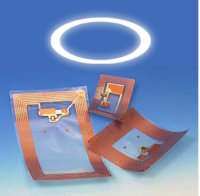May 24, 2006
Tag Along
 Yesterday I presented my report on RFID tags, "Den Hänsynsfulla Taggen" (in Swedish) at a seminar hosted by Hitachi where I discussed with Pär Ström and the audience how to get the benefits from the technology without losing privacy.
Yesterday I presented my report on RFID tags, "Den Hänsynsfulla Taggen" (in Swedish) at a seminar hosted by Hitachi where I discussed with Pär Ström and the audience how to get the benefits from the technology without losing privacy.
The report describes RFID technology and some possible applications, ranging from the obvious (replacement/substitute for product marking) over the unusual (marking holy cows to prevent people from being paid return fees twice) and playful (sending files using nerf darts) to the futuristic (a world where everything is identifiable).
In general RFID is just one kind of identity technology: methods of maing objects "know" who, what and whose they are, and allowing automated systems to make use of this information. It could just as well be done using traditional EAN codes, QR codes, pattern recognition, laser fingerprints, biometrics and other systems. Identity technology is IMHO just as transformative as information technology, biotechnology, nanotechnology and artificial intelligence. It is a general technology that can be applied to nearly anything, combined with other technologies and likely to spawn many new and currently unthinkable applications.
The big problem is of course that many are up in arms about the integrity risks. Leaving out total paranoia, it is clear that enabling reliable and discreet tracking of things and people poses problems. Pär was mostly concerned with people tracking, but even our possessions contain parts of our extended selves. I proposed a number of remedies to get the best out of the situation:
- Constructing trust, both by designing trustworthy systems and by engaging stakeholders of all kinds in the development process. Some problems can be solved by engineering, like security, blockable tags or how to handle the data. But much is going to be social interactions: do we trust the different stakeholders and their methods and goals?
- A focus on end user benefits. Consumers have nothing against GMO in Europe if they see a lower price or higher nutrient count; consumers would love RFID tags if they visibly lowered prices or gave their goods useful capabilities.
- Develop visible and transparent technology. It should not be secretive, and its activity should be possible to monitor. Tags should have clear owners and defined loyalties. Maybe we should make markup describing the tag system a standard feature, so that people can if they wish check out unfamiliar aspects of an objects identity.
- Give the user a sense of control over it. This includes the ability to turn off, remove or shield tags, but also the ability to read tags in the vicinicty and to write to owned tags.
- Getting people to discuss the values and visions they have for their technology. Just explaining why tags are used makes people much more comfortable with them, and admitting the dreams driving much development enables more broad and deep discussions about means and ends.
- Enable experimentation with the technology. There is a big risk that industry and critics just think of the big applications like supply chains, producing regulations that are based on these assumptions. But general technologies are innovation friendly. To get the maximum benefit we should have a broad base of bottom upp experimentation, ranging from RFID hackers to kids to entrepreneurs, and the understanding that we will see many utterly unexpected uses. Regulations ought to not gel too fast, since they might otherwise trap the technology based on the assumptions of an early stage.
- Pär wanted a constitutional right for anonymity, I proposed the heuristic that any expansion of the surveillance rights of organisations must be met by a corresponding expansion of public oversight.